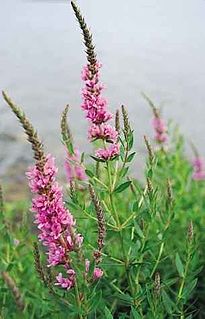
Lythraceae is a family of flowering plants, including 32 genera, with about 620 species of herbs, shrubs, and trees. The larger genera include Cuphea, Lagerstroemia (56), Nesaea (50), Rotala (45), and Lythrum (35). It also includes the pomegranate and the water caltrop. Lythraceae has a worldwide distribution, with most species in the tropics, but ranging into temperate climate regions as well.
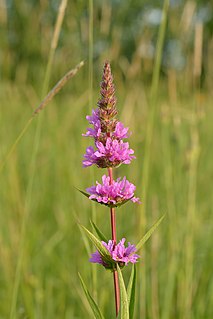
Lythrum salicaria or purple loosestrife is a flowering plant belonging to the family Lythraceae. It should not be confused with other plants sharing the name loosestrife that are members of the family Primulaceae. Other names include spiked loosestrife and purple Lythrum. This herbaceous perennial is native to Europe and Asia, and possibly Australia.

Lysimachia is a genus consisting of 193 accepted species of flowering plants traditionally classified in the family Primulaceae. Based on a molecular phylogenetic study it was transferred to the family Myrsinaceae, before this family was later merged into the Primulaceae.
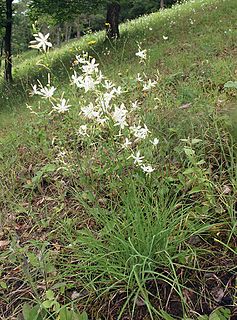
Anthericum is a genus of about 65 species, rhizomatous perennial plants in the family Asparagaceae, subfamily Agavoideae. It was formerly placed in its own family, Anthericeae. The species have rhizomatous or tuberous roots, long narrow leaves and branched stems carrying starry white flowers. The members of this genus occur mainly in the tropics and southern Africa and Madagascar, but are also represented in Europe.

Sterculia is a genus of flowering plants in the mallow family, Malvaceae: subfamily Sterculioideae. Members of the genus are colloquially known as tropical chestnuts. Sterculia may be monoecious or dioecious, and its flowers unisexual or bisexual.
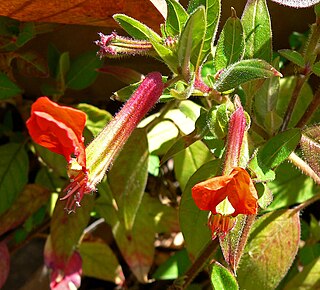
Cuphea is a genus containing about 260 species of annual and perennial flowering plants native to warm temperate to tropical regions of the Americas. The species range from low-growing herbaceous plants to semi-woody shrubs up to 2 m tall. Commonly they are known as cupheas, or, in the case of some species, as cigar plants. The generic name is derived from the Greek word κυφος (kyphos), meaning "bent," "curved," or "humped."

Eleocharis is a virtually cosmopolitan genus of 250 or more species of flowering plants in the sedge family, Cyperaceae. The name is derived from the Greek words ἕλειος (heleios), meaning "marsh dweller," and χάρις (charis), meaning "grace." Members of the genus are known commonly as spikerushes or spikesedges. The genus has a geographically cosmopolitan distribution, with centers of diversity in the Amazon Rainforest and adjacent eastern slopes of the South American Andes, northern Australia, eastern North America, California, Southern Africa, and subtropical Asia. The vast majority of Eleocharis species grow in aquatic or mesic habitats from sea level to higher than 5,000 meters in elevation.
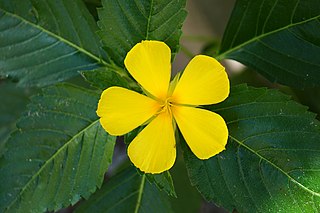
Turnera is a genus of flowering plants in the passionflower family, Passifloraceae. It contains more than 100 species native to tropical and subtropical America. The name honours English naturalist William Turner (1508–1568). It was previously placed in the family Turneraceae.

Cuphea viscosissima, also known as blue waxweed, clammy cuphea or (ambiguously) as "tarweed", is an herbaceous plant in the loosestrife family. It native to the eastern United States, where it is most often found in open, rocky calcareous areas. It is the most common and widespread Cuphea in the U.S.

Parsonsia is a genus of woody vines in the family Apocynaceae. Species occur throughout Indomalaya, Australasia and Melanesia.

Lythrum californicum is a species of flowering plant in the loosestrife family known by the common name California loosestrife. It is native to northern Mexico and the southwestern United States into the Midwest as far east as Oklahoma and Texas. It often grows in moist habitat. This is an erect perennial herb reaching 20 to 60 cm tall, sometimes branching. The waxy linear to lance-shaped leaves are arranged oppositely lower on the plant, and alternately toward the top. They are 1 to 7 cm in length. The inflorescence is a terminal spike of flowers with purple petals under a centimeter long. Flowers are heterostylous on one individual plant, with some having long, protruding styles and some with shorter styles not protruding from the mouth of the flower. The fruit is an oval capsule containing many minute seeds.
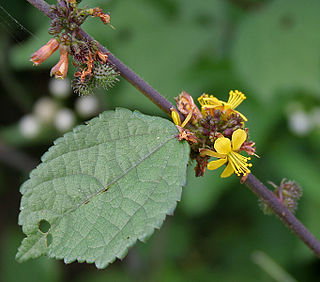
Triumfetta is a genus of plants in the family Malvaceae. Burbark is a common name for plants in this genus.

Lumnitzera is an Indo-West Pacific mangrove genus in the family Combretaceae. An English common name is black mangrove. Lumnitzera, named after the German botanist, Stephan Lumnitzer (1750-1806), occurs in mangroves from East Africa to the Western Pacific, and northern Australia.

Hylobius transversovittatus is a species of weevil in the family Curculionidae. It is native to the Old World where both adults and larvae feed on purple loosestrife. This plant is regarded as an invasive species in North America and the weevil has been introduced into both the United States and Canada in an effort to control the plant.

Lythrum alatum, commonly known as winged loosestrife, winged lythrum or angled purple-loosestrife, is a species of flowering plant belonging to the family Lythraceae. It is endemic to wetland areas in central and eastern United States and Ontario.

Galerucella calmariensis is a species of leaf beetle in the family Chrysomelidae. It is commonly known as the black-margined loosestrife beetle and is native to Europe and Asia where both adults and larvae feed on purple loosestrife. It has been introduced in North America as a biological control agent for purple loosestrife.

Lythrum junceum is a species of perennial herb in the family Lythraceae native to the Mediterranean Basin, West Asia and Macaronesia. They have a self-supporting growth form and simple, broad leaves. They are associated with freshwater habitat. Individuals can grow to 0.2 m.

















